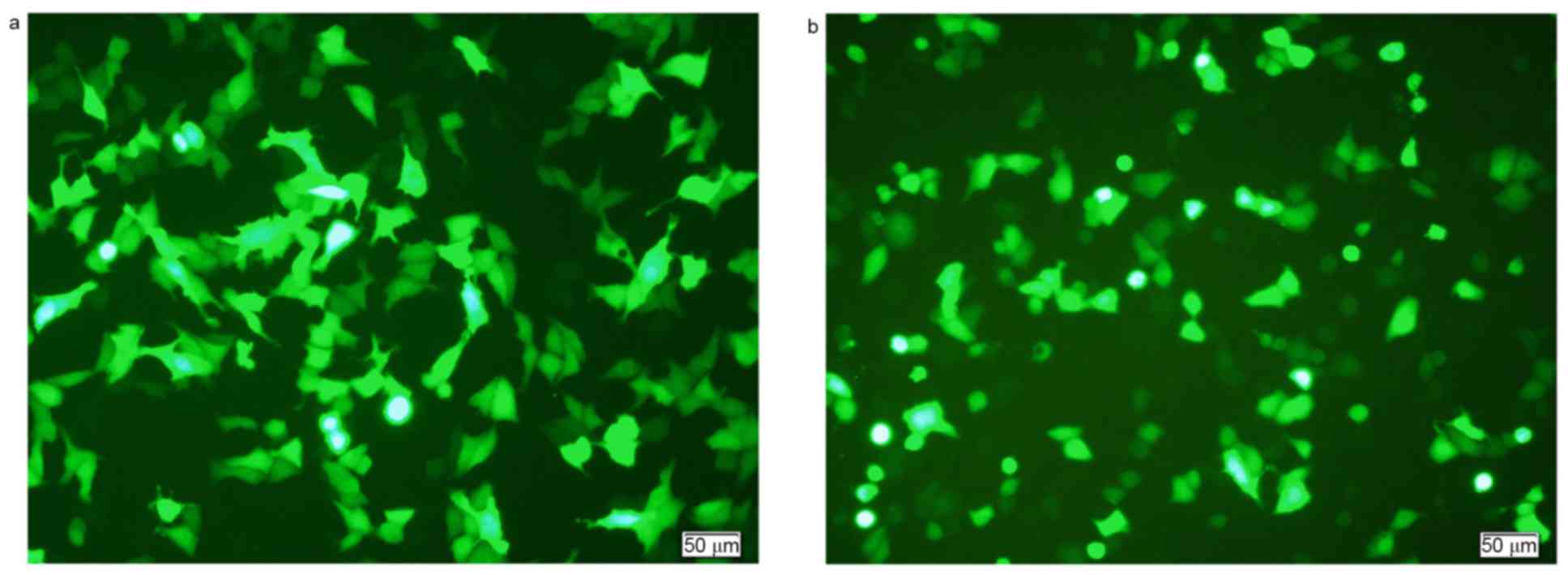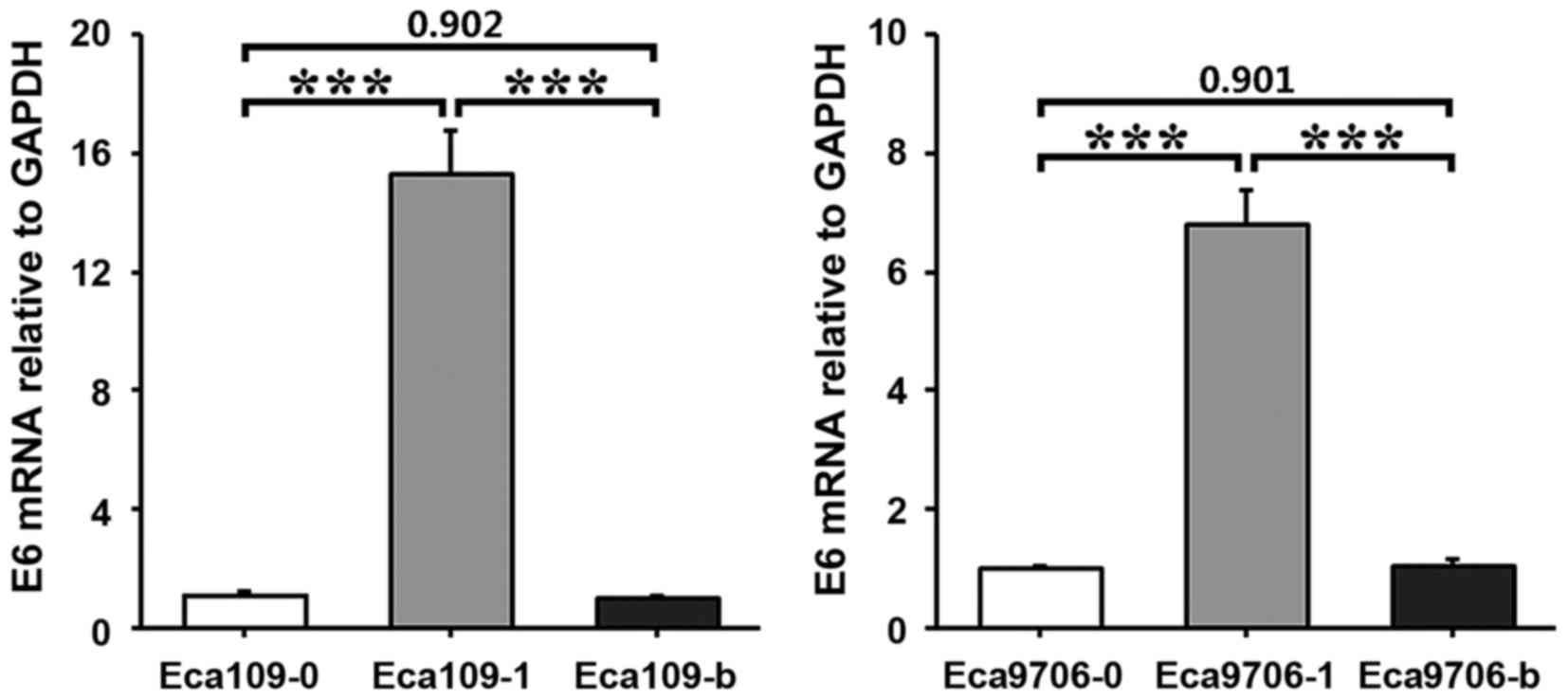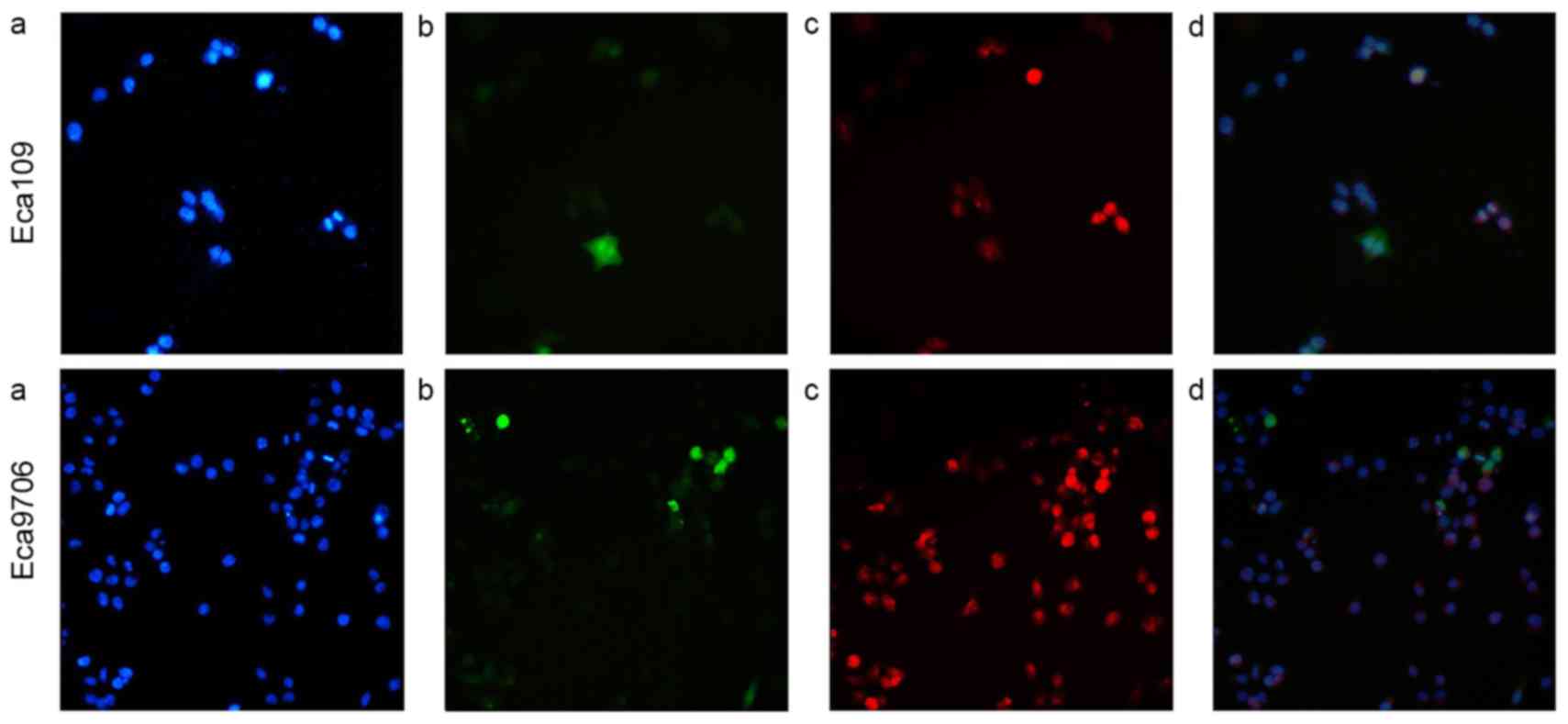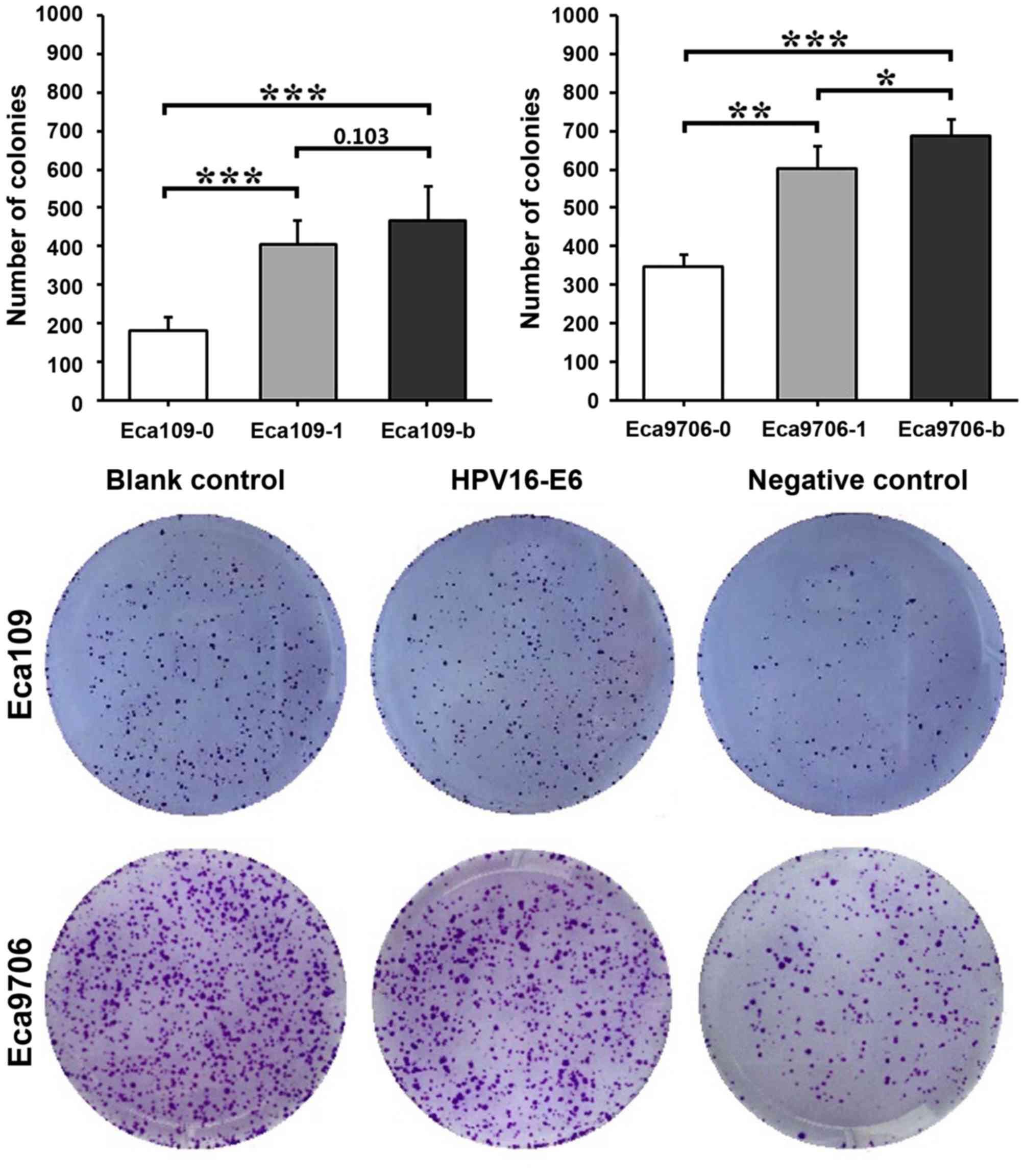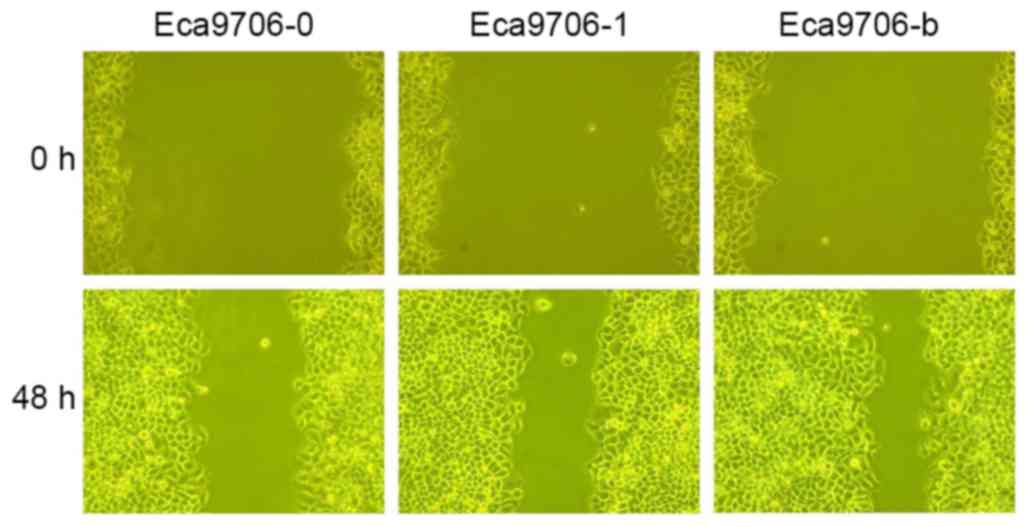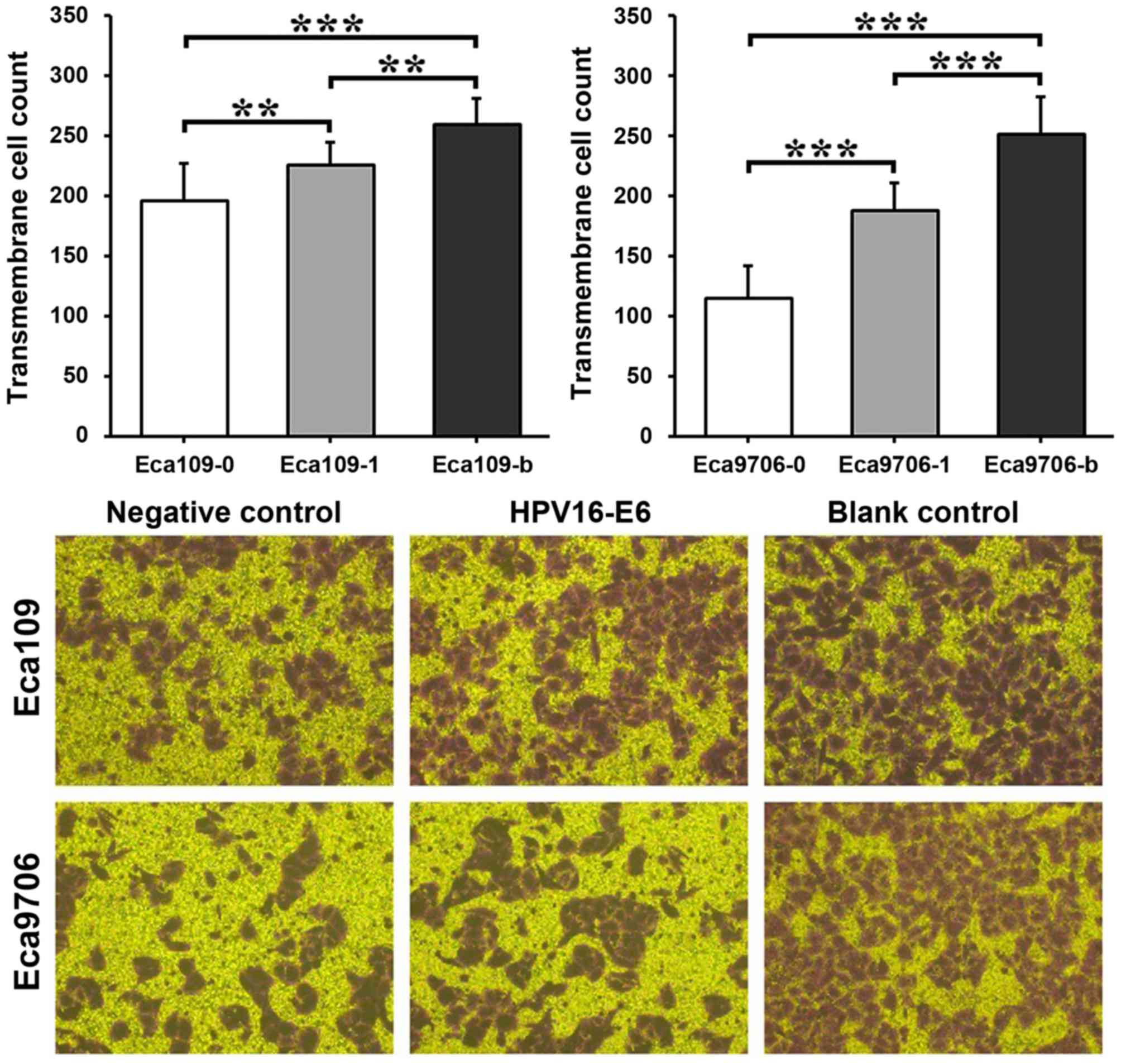Effects of HPV16E6 transfection on the biological behavior of Eca109 and Eca9706 cells
Corrigendum in: /10.3892/ol.2021.12552
- Authors:
- Published online on: November 22, 2017 https://doi.org/10.3892/ol.2017.7469
- Pages: 1646-1654
-
Copyright: © Kang et al. This is an open access article distributed under the terms of Creative Commons Attribution License.
Abstract
Introduction
Esophageal cancer, one of the most common upper digestive tract tumors, may be divided into esophageal squamous carcinoma and adenocarcinoma (1). According to statistical data, esophageal squamous carcinoma is the major subtype in developing countries, and adenocarcinoma of the esophagus is more common in developed countries (2). China is located in the ‘Asian area with high esophageal cancer occurrence’ and is the country with the highest mortality rate of esophageal cancer. However, the pathogenesis of esophageal cancer is not yet clear (3). Previously, an association between human papillomavirus (HPV) and cervical cancer has been established and relevant preventive vaccines have been released; scholars from different countries have gradually turned toward studies on HPV infection and non-genital cancers (4). It has been indicated in clinical literature that HPV16 may be detected in specimens of esophageal cancer, suggesting that HPV16 is involved in the occurrence and progression of esophageal cancer (5,6). Nested polymerase chain reaction (PCR) was adopted in a preliminary study to test HPV infection subtype in Kazak esophageal squamous carcinoma, indicating high expression of HPV16 in esophageal squamous carcinoma (7). Also, it was suggested that the level of HPV16E6 protein expression was a key factor maintaining the malignant phenotype of cancer, and it may serve a notable function in the occurrence and course of esophagus cancer (8,9). As the mechanism of HPV16 in causing and promoting cancer is relatively clear in studies concerning cervical cancer (10), detection of HPV in esophageal cancer cases is worthy of further study, and may have a notable impact on the diagnosis and treatment of esophageal cancer.
HPVs are a type of small, circular and double-stranded DNA virus without a cell membrane (11). They are highly specific to their host-species. High-risk HPV types are of tensaid to be associated with malignant squamous cell tumors such as reproductive system tumors, esophageal cancer and mouth neoplasm (12). Based on function, the genomic structure of HPV can be divided into three coding regions, including the early, late and upstream regulation regions (13). E6 and E7 are viral oncoproteins; the latter majorly involves cell transformation during early cancer stage and the former involves malignant transformation during late stage (14). Although high expression of HPV16 in pathological specimens of esophageal cancer has been indicated in numerous studies (15), the effects of HPV16 on proliferation, invasion, migration and other biological features of esophageal squamous carcinoma remain unclear.
Materials and methods
Cell culture
Human esophageal cancer cells, Eca109 and Eca9706 (Cell Bank of The Chinese Academy of Sciences, Shanghai, China), were routinely cultured in Dulbecco's modified Eagle's medium (DMEM; Gibco; Thermo Fisher Scientific, Inc., Waltham, MA, USA) culture solution (including 1% penicillin-streptomycin mixture) with 10% fetal calf serum (Hyclone; GE Healthcare Life Sciences, Logan, UT, USA). Cells were cultured in an incubator at 37°C and 5% CO2. When cell fusion reached 80–90%, trypsinization was used for sub-culture. Cells sub-cultured in logarithmic phase were used for the experiments.
Plasmid extraction
A total of 5 µl pcDNA3.1+ (Carrying HPV16-E6 gene fragments; Sangon Biotech Co., Ltd., Shanghai, China) recombinant plasmid-containing competent cells (Escherichia coli cells; Sangon Biotech Co., Ltd., Shanghai, China) were selected and cultured in Luria-Bertani (LB) solid medium (16) at 37°C for 12 h. Monoclonal cells were selected overnight and inoculated in 40 ml LB fluid medium (17). Ampicillin (30 µg/ml) was added to the medium at a ratio of 1:100. The conical flask was placed in a shaker (37°C; rotation speed of 2.96 × g) for overnight vibration. The next day, a Column Plasmid Mini Preparation kit (Tiangen Biotech Co., Ltd., Beijing, China) was used to extract plasmids according to the manufacturer's protocol. The purity and concentration of the extracted plasmids was determined with a micro-volume spectrophotometer (NanoDrop 2000; Thermo Fisher Scientific, Inc.).
Cell transfection
Human esophageal cancer Eca109 and Eca9706 cells were evenly plated onto a 6-well plate in Opti-MEM (Gibco; Thermo Fisher Scientific, Inc.) and cultured at 37°C. Once cell fusion reached 70–80%, Lipofectamine 2000 (Invitrogen; Thermo Fisher Scientific, Inc.) was used as the transfection reagent to transfect the plasmids (10 µg; containing HPV16E6 genes) into esophageal cancer cells, which were named Eca109-1 and Eca9706-1. Esophageal cancer cells transfected with nonsense segments were named as Eca109-0 and Eca9706-0 as negative controls. Untreated esophagus cancer cells, Ecal109-b and Eca9706-b, were adopted as blank controls.
Quantitative-PCR (qPCR)
Total DNA of HPV16E6-transfected esophageal cancer cells was extracted using TRIzol (Qiagen GmbH, Hilden, Germany), according to the manufacturer's protocol. The fluorophore used was SYBR Green kit (Qiagen GmbH) and β-actin was used as the reference gene. PCR conditions were as follows: Pre-denaturation at 94°C for 10 min; 30 cycles of thermo cycling (denaturation at 94°C for 30 sec, annealing at 55°C for 1 min and extension at 72°C for 3 min); extension at 72°C for 10 min; and completion at 4°C. The presence of E6 DNA was determined with PCR extension. For E6mRNA amplification (Sangon Biotech, China), the sequences of the primers were as follows: Forward, 5′-CGGAATTCATGCACCAAAAGAG-AACTGCA-3′ and reverse, 5′-CCCAAGCTTACAGCTGGGTT-TCTCTACG-3′. GAPDH was used as an internal control, with the sequences of primers as follows: Forward, 5′-GAPDH-FCAAGGTCATCCATGACAACTTTG-3′ and Reverse, 5′-GAPDH-RGTCCACCACCCTGTTGCTGTA-3′. The qPCR thermo cycling conditions were as follows: Initial heat activation at 95°C for 2 min, denaturation at 95°C for 5 sec and combined annealing 60°C for 10 sec for 40 cycles. The experiment was repeated 3 times. Relative expression of HPV16E6 was calculated using the 2−∆∆Cq method (18).
Immunofluorescence test
Glass slides were horizontally placed in a 6-well plate for cell culture. When cell growth reached 50–60%, transfection in groups was conducted. At 24 h, transfection efficiency (number of fluorescent cells/total number of cells) was determined with a fluorescence microscope and the transfection was terminated by DMEM, supplemented with 10% fetal calf serum after cell fixation. Briefly, the slides were washed with pre-heated PBS three times, and then 4% paraformaldehyde (2 ml/well) was added for 10 min at room temperature. The slides were washed three times with PBS. Then, 0.1% Triton X-100 (2 ml/well) was added and incubated at room temperature for 5 min for cell permeability. The slides were washed with PBS three times. Once cell fusion reached 70–80%, PBS was used to dilute primary antibodies (1:50) and then the slides were incubated with goat anti-mouse HPV16E6 polyclonal immunoglobulin G (IgG) (primary antibodies, cat no sc-1583, Santa Cruz Biotechnology, Inc., Dallas, TX, USA) at 4°C overnight. The slides were washed with PBS three times. Subsequently, goat anti-mouse IgG, tetramethylrhodamine-conjugated secondary antibodies, (cat no 6921–100, BioVision, Inc., Milpitas, CA, USA) were diluted with PBS (1:50) and were incubated with the slides at room temperature for 1 h. The slides were washed with PBS three times. Cell nuclei were stained with DAPI at room temperature for 10 min and the slides were observed under a fluorescence microscope (×100).
Western blot analysis
After 48 h of transfection, the total protein was extracted from cells using radioimmunoprecipitation assay and phenylmethane sulfonyl fluoride protein lysis buffer for 20 min at 4°C (Applygen Technologies, Inc., Beijing, China). Subsequently, samples were a centrifuged at 1,200 × g for 20 min at 4°C to obtain the total protein. Protein concentration was measured on NanoDrop 2000 (Thermo Fisher Scientific, Inc.) Proteins (20 µl, 40 mg/ml) were separated by 15% SDS-PAGE and transferred to polyvinylidene difluoride membranes. The membranes were blocked with 5% skim milk powder for 2 h. Goat anti-mouse HPV16E6 polyclonal IgG (dilution, 1:200; cat no. sc-1583, Santa Cruz Biotechnology, Inc.) were applied to the membrane and incubated at 4°C overnight. The membranes were washed with PBS-Tween-20 (PBST). Goat anti-mouse IgG horseradish peroxidase-conjugated antibodies (dilution, 1:3,300; cat no. ZB-2306, OriGene Technologies, Inc., Beijing, China) were added and incubated at room temperature for 2 h, prior to the membrane being washed with PBST. HPV16E6 protein expression was evaluated using an enhanced chemiluminescence kit (West Pico PLUS Chemiluminescent Substrate; Thermo Fisher Scientific, Inc.) and β-actin was adopted as an internal reference: Mouse anti-β-actin as primary antibodies (dilution, 1:1,000; cat no. TA-09, OriGene Technologies, Inc.) and Go at anti-mouse IgG horseradish peroxidase-conjugated antibodies (dilution, 1:2,000; cat no. ZB-2305, OriGene Technologies, Inc.). The experiment was repeated three times.
Cell proliferation analysis
Cells of logarithmic phase were transferred to a 6-well plate for 24 h cell transfection. A cell suspension using DMEM was prepared by dissociation and re-suspension and was then transferred onto a 96-well plate. A volume of 100 µl cell suspension was added to each well (4,000 cells/well). The plate was placed in an incubator (37°C, 5% CO2) for 3 h for coherence (regarded as ‘0 h’), and 10 µl CCK-8 solution (Dojindo Molecular Technologies, Inc., Shanghai, China) was added at 0, 12, 24, 48, 72 and 96 h. Three wells were set for each group. The culture plate was incubated in the incubator for 2 h. The optical density (OD) at 460 nm was determined with a microplate reader. The OD values represented the cell proliferation capacity.
Plate colony formation assay
Cells of logarithmic phase transfected for 24 h were used, along with DMEM, to prepare a cell suspension. The infinite dilution method was adopted to incubate cells in a 6-well plate (1,000 cells/well). The plate was agitated gently to spread the suspension and incubated in an incubator at 37°C (5% CO2). The medium was changed every 4–5 days, for a total of 2 weeks. The culture was stopped when visible colonies appeared on the plate. The culture solution was removed and the plate was rinsed with PBS buffer solution twice. The colony was fixed by adding 4% paraformaldehyde for 15–20 min (37°C). Following natural drying, moderate 0.1% crystal violet was added for 15–20 min (37°C). The residual dye was washed off with water and the plate was air-dried. The number of colonies with >50 cells were counted under a fluorescence inverted microscope (×71 magnification; Olympus Corporation, Tokyo, Japan).
Wound healing assay
Cells of logarithmic phase were transferred to a 6-well plate (~7×105 cells/well) and placed in an incubator overnight (37°C, 5% CO2). Cells were transfected in groups when fusion reached 70–80%. At 24 h after transfection, a scratch was made in the 6-well plate with a 10 µl micropipette. Serum-free medium was added after washing off detached cells with PBS. The scratches were observed following culture for 0, 12, 24, 36 and 48 h using an inverted fluorescence microscope (×71 magnification; Olympus Corporation, Tokyo, Japan). Scratch width ratios were calculated as follows: Scratch width ratio=(end width/initial width) ×100%.
Cell invasion assay
A total of 5 µl Matrigel (BD Biosciences, Franklin Lakes, CA, USA) and 40 µl serum-free DMEM (1:8) were mixed in an Eppendorf tube (both the tip and DMEM underwent pre-cooling treatment). A volume of 45 µl solution was used to cover the bottom of the transwell insert (Corning Life Sciences, Corning, NY, USA). The chambers were subsequently placed in an incubator for 2–3 h. The residual liquid in the upper chamber was removed following solidification, 80 µl serum-free DMEM was added and the chamber was placed in the incubator for 30 min hydration. After 24 h transfection, cells were dissociated with trypsin, re-suspended in serum-free DMEM and 200 µl was added to the upper chamber (~8×104 cells/well) prior to the addition of 600 µl complete medium containing 20% serumto the lower chamber. Following incubation for 48 h, 100 and 600 µl preheated PBS was added to the upper and lower chambers respectively, chambers were washed 1–2 times and PBS in the upper chambers was discarded. A total of 600 µl pre-cooled paraformaldehyde (4%) was added to the upper chamber for cell fixing at 4°C for 20 min. Transwell inserts were placed in PBS to be washed. Residual liquids were removed from the chamber and allowed to dry naturally. Crystal violet (0.1%; 600 µl) was added to the lower chamber to stain the cells in transwell inserts for 20 min at room temperature. Transwell inserts were then washed twice with PBS and any un-migrated cells on the surface of the microporous membrane were removed. Finally, cell migration was observed using light microscopy (magnification ×100; ×71 magnification; Olympus Corporation, Tokyo, Japan) for subsequent statistical analysis.
Statistical analysis
All experiments were conducted independently three times. In the in vitro wound healing and invasion assays, a total of five fields of view were randomly selected and examined at ×100 magnification for each experimental group. Experimental data and results were analyzed with SPSS 17.0 software (SPSS, Inc., Chicago, IL, USA). Image J (version 1.48) image processing software (National Institutes of Health, Bethesda, MD, USA) was used for cell counting. Image-Pro Plus 6.0 (Media Cybernetics, Inc., Rockville, MD, USA) was used to measure the widths of scratches. Experimental data are presented as the mean ± standard deviation. Data were analyzed by one-way analysis of variance followed by Bonferroni's multiple comparison test. P<0.05 was considered to indicate a statistically significant difference.
Results
Transfection efficiency
The peak transfection efficiency of Eca109 cells was~40%. The conditions for highest efficiency transfection were as follows: 10 µg DNA (plasmid) per well; ratio of Lipofectamine 2000 to DNA of 1:1; 12 h transfection time; and no starvation performed before transfection. The peak transfection efficiency for Eca9706 cells was ~30%, with the following conditions: 10 µg DNA (plasmid) per well; ratio of Lipofectamine 2000 to DNA of 1:1; 24 h transfection time; and 6 h starvation performed before transfection. Representative images of peak transfection efficiency are presented in Fig. 1.
RT-qPCR results
HPV16E6 esophagus cancer cells were treated separately to establish Eca109-0, Eca109-1, Eca109-b, Eca9706-1, Eca9706-0 and Eca9706-b cells. Total DNA extracted from transfected esophageal cancer cells underwent PCR amplification. The amplified products underwent electrophoresis. This indicated a specific band at ~500 bp, which was consistent with the target gene HPV16E6 (474 bp). RT-qPCR indicated that E6 mRNA expression levels were significantly higher in Eca109-1 cells compared with Eca109-0 or Eca109-b cells (P<0.001; Fig. 2). E6 mRNA expression levels were also significantly higher in Eca9706-1 cells compared with Eca9706-0 or Eca9706-b cells (P<0.001; Fig. 2).
Immunofluorescence assay results
An immunofluorescence assay was used to determine expression of HPV16E6 in esophageal cancer cells Eca109 and Eca9706. The results indicated that HPV16E6 was widely distributed in the cell nuclei and cytoplasm (Fig. 3).
Western blot analysis
After cells had been transfected with plasmid for 48 h, western blot analyses were conducted, with β-actin as the internal reference (Fig. 4). An obvious band was observed in the 17 kb position in the transfection groups, while no obvious bands were indicated in the nonsense transfected group or the blank control group. These results indicated that transfection with recombinant plasmid (HPV16E6pcDNA-3.1) had resulted in upregulated HPV16E6 protein expression.
Cell proliferation assay result
OD values during different stages and in different groups measured with microplate reader are presented in Table I. The results at 48 h indicated that the OD values of Eca109-1 were significantly higher compared with Eca109-0 and Eca109-b (P<0.05), while no statistically significant difference in OD was observed between Eca109-b and Eca109-0 (P=0.071). For Eca9706 cells, statistically significant differences were observed between different experimental groups (P<0.05), which were ranked as Eca9706-1>Eca9706-b>Eca9706-0, with respect to OD value.
Cell colony formation assay
The results of the colony assay indicated that the colony formation capacity was strongest in the blank control groups and weakest in the negative control groups (Fig. 5). In Eca109 cells, Eca109-0 exhibited significantly fewer colonies compared with Eca109-1 (P<0.001) or Eca109-b (P<0.001) cells. However, no significant difference was observed between Eca109-1 and Eca109-b cells (P=0.103). In Eca9706 cells, Eca9706-0 cells exhibited significantly fewer colonies compared with Eca9706-1 (P<0.01) or Eca9706-b (P<0.001) cells. Eca9706-1 cells also exhibited significantly fewer colonies compared with Eca9706-b cells (P<0.05).
Wound healing assay
Scratch width ratios of experimental groups at different time points are presented in Table II. The results at 48 h indicated that lower scratch width ratios were associated with longer growth times in different cell groups. In Eca109 cells, Eca109-b exhibited significantly lower scratch width ratio with Eca109-1 (P<0.05) and Eca109-0 (P<0.05). Meanwhile, the scratch width ratio in Eca109-1 was significantly lower than that of Eca109-0 (P<0.05). In Eca9706 cells, the scratch width ratio in Eca9706-0 was significantly higher compared with Eca9706-1 (P<0.05) and Eca9706-b (P<0.05), while no statistically significant difference was observed between Eca9706-1 and Eca9706-b (P=0.121). Representative images of the wound healing assay are presented in Fig. 6.
Cell invasion assay results
The invasion capacity was similar in the two esophageal cancer cell types (Fig. 7). The blank control group exhibited a significantly higher invasion capacity compared with the transfection group (P<0.01 in Eca109 and P<0.001 in Eca9706) and negative control group (P<0.001 in the two cell types). In addition, the transfection group exhibited a significantly higher invasion capacity compared with the negative control group (P<0.01 in Eca109 and P<0.001 in Eca9706).
Discussion
Syrjanen (19) was the first to identify that morphological change of esophageal squamous carcinoma was similar to that of condyloma of the genital system and speculate that HPV infection maybe a risk factor for esophageal cancer. Since then, another study demonstrated HPV16E6 is closely is closely associated with tumorigenesis at the gene, mRNA, protein and other levels (20). With in-depth studies on oncogenes, it has been identified that HPV16E6 protein serves a critical function in carcinogenic development, as it activates transcription of human telomerase reverse transcriptase, collaborates with E7 protein to inactivate retinoblastoma protein and promotes cell immortalization (21,22). It has been suggested in numerous clinical studies and investigations that HPV is associated with esophageal cancer and HPV infection may promote development of esophageal cancer (5–8,23). Tumor development is a complicated process associated with multiple possible mechanisms. Early expressed genes of HPV16 may be involved in tumorigenesis and progression in cell cycles (6,7), but it has not yet been reported whether E6 regulates and controls proliferation, invasion and migration of tumor cells in esophageal cancer. Therefore, in the present study, HPV16E6 was used to transfect Eca109 and Eca9706 esophageal cancer cells, and the effects on biological properties of these cell lines were observed.
In fluorescence microscope images in the present study, it was demonstrated that positive liposome-mediated HPV16E6 successfully transfected esophageal cancer cell lines Eca109 and Eca9706, and stable cell lines were achieved by screening. This laid a foundation for studying the etiology and mechanism of esophageal cancer. With respect to function, it was demonstrated with RT-PCR that the transfected esophagus cancer cells contained the target gene, HPV16E6, and HPV16E6mRNA, which was demonstrated at the protein level. It was indicated by the immunofluorescence assay and western blot analysis that HPV16E6 protein was expressed in the transfection group, but not in the blank or negative control group. HPV16E6 expression was distributed in the cytoplasm and cell nucleus. The results also suggested that the transfection efficiency was higher in poorly-differentiated Eca109 cells compared with well-differentiated Eca9706 cells. This finding was consistent with previous research, which identified that HPV16E6 expression is correlated with a decreased degree of tissue differentiation (24).
In the present study, cell proliferation in in the target gene-transfected esophageal cancer cell lines was significantly higher compared with the negative control groups, and increased over time. Similarly, in the cell colony formation assay, the number of cell colonies was significantly in the transfected cell groups compared with negative control groups. These results suggest that cell proliferation ability is improved after HPV infection. The results of the wound healing assay indicated that the migratory capacity was higher in the transfected groups compared with the negative control groups. Similarly, in the Transwell Matrigel assay, the number of membrane-crossing cells was significantly higher in the experimental groups compared with the negative control groups, suggesting that invasion capacity was increased in HPV16E6-transfected cells. These results suggested that expression of HPV16E6 may be associated with proliferation, invasion and migration of esophageal cancer. Eca109 cells exhibited higher transfection efficiency but lower proliferation capacity compared with Eca9706 cells, suggesting that HPV16E6 exerts greater effects on well-differentiated Eca9706 compared with poorly-differentiated Eca109. However, Eca109 cells exhibited stronger invasion and migration abilities compared with Eca9706 cells. The reason for this may be that Eca109 cells are poorly differentiated esophageal cancer cells with high malignancy, or that the high transfection efficiency of Eca109 leads to greater effects of HPV16E6. The underlying mechanisms of these differences require further investigation. The current results also identified that non-transfected (blank control) cell lines have slightly stronger proliferation, invasion and migration capacities compared with nonsense transfected (negative control) cell lines, suggesting that transfection causes a certain level of injury to esophageal cancer cells (25,26).
The effects of HPV16E6 on esophageal cancer cells may be associated with the following mechanisms. P53 is an extensively studied cancer suppressor gene and is involved in almost half of human malignant tumor types (27). It has been indicated in certain studies that, in HPV16E6-infected esophagus cancer cells, p53 couples with E6 protein closely to inhibit p53 from entering the cell nucleus. In addition, the ubiquitin-dependent protease system facilitates p53 protein degradation to disable effective p53 expression. This results in inactivated regulatory functions of cell cycle-related factors (including P21, proliferating cell nuclear antigen, cyclins and cyclin-dependent kinases), shortened G1/S stage, hindered cell apoptosis and cell cycle arrest, reactivated DNA synthesis mechanisms, and duplicated virus DNA (28,29). Therefore, the effects of HPV16E6 on the normal functions of p53 indicate particular significance for carcinogenicity (30,31). It has also been demonstrated in previous studies that HPV16E6 can allow cells to escape the proliferation limit of senescence and immortalize normal cells by activating telomerase (32–34).
In conclusion, positive liposome-mediated HPV16E6 successfully transfected Eca109 and Eca9706 cell lines and E6 protein was stably expressed in transfected cell lines. Cell lines with stable expression of HPV16E6, achieved with a screening process, facilitated studies of the biological functions of E6 proteins at the cellular level. By observing the biological effects of HPV16E6 transfection in differently differentiated esophageal cancer cells, it was identified that E6 induces cell proliferation and promotes malignancy (invasion and migration capacity). These findings lay a foundation for further study of the association between HPV and esophageal cancer and provide theoretical guidance for the prevention and treatment of HPV-associated esophageal cancer. Further studies are required to identify the underlying mechanism of HPV16E in tumorigenesis and progression.
Acknowledgements
The present study was supported by the National Natural Science Foundation of China (grant no. 81260362).
References
|
Power DG, O'Sulleabhain C and Murphy TJ: Preoperative chemoradiotherapy for esophageal cancer. Australasian Radiol. 43:215–219. 2001. | |
|
Lin Y, Totsuka Y, He Y, Kikuchi S, Qiao Y, Ueda J, Wei W, Inoue M and Tanaka H: Epidemiology of esophageal cancer in Japan and China. J Epidemiol. 23:233–242. 2013. View Article : Google Scholar : PubMed/NCBI | |
|
Chen W, Zheng R, Zhang S, Zeng H, Fan Y, Qiao Y and Zhou Q: Esophageal cancer incidence and mortality in China, 2010. Thoracic Cancer. 5:343–348. 2014. View Article : Google Scholar : PubMed/NCBI | |
|
Cao BW, Jing-Lin YU, Huan HE, Shen-ta LI and Yu-lian Z: Meta-analysis on the Relationship between HPV infection and esophageal cancer in Chinese Population. J Capital Med Univ. 97:148–150. 2010. | |
|
Wang X, Tian X, Liu F, Zhao Y, Sun M, Chen D, Lu C, Wang Z, Shi X, Zhang Q, et al: Detection of HPV DNA in esophageal cancer specimens from different regions and ethnic groups: A descriptive study. BMC Cancer. 10:192010. View Article : Google Scholar : PubMed/NCBI | |
|
Zhou Y, Pan Y, Zhang S, Shi X, Ning T and Ke Y: Increased phosphorylation of p70 S6 kinase is associated with HPV16 infection in cervical cancer and esophageal cancer. Br J Cancer. 97:218–222. 2007. View Article : Google Scholar : PubMed/NCBI | |
|
Chen WG, Yang CM, Xu LH, Zhang N, Liu XY, Ma YG, Huo XL, Han YS, Tian DA and Zheng Y: Gene chip technology used in the detection of HPV infection in esophageal cancer of Kazakh Chinese in Xinjiang province. J Huazhong Univ Sci Technolog Med Sci. 34:343–347. 2014. View Article : Google Scholar : PubMed/NCBI | |
|
Dong GC: Multiple PCR-mass spectrometry detection of kazak in xinjiang esophageal cancer HPV infection and genotype distribution. Xinjiang Shihezi Univ. 26–27. 2014. | |
|
Chen YW, Wu MF, Wand J, Yeh KT, Goan YG, Chiou HL, Chen CY and Lee H: Human papillomavirus 16/18 E6 oncoprotein is expressed in lung cancer and related with p53 inactivation. Cancer Res. 67:10686–10693. 2007. View Article : Google Scholar : PubMed/NCBI | |
|
Skinner SR, Apter D, De Carvalho N, Harper DM, Konno R, Paavonen J, Romanowski B, Roteli-Martins C, Burlet N, Mihalyi A and Struyf F: Human papillomavirus (HPV)-16/18 AS04-adjuvanted vaccine for the prevention of cervical cancer and HPV-related diseases. Expert Rev Vaccines. 15:367–387. 2016.PubMed/NCBI | |
|
Moody CA and Laimins LA: Human papillomavirus oncoproteins: Pathways to transformation. Nat Rev Cancer. 10:550–560. 2010. View Article : Google Scholar : PubMed/NCBI | |
|
Huang H, Zhang B, Chen W, Zhou SM, Zhang YX, Gao L, Xu ZG, Qiao YL and Tang PZ: Human papillomavirus infection and prognostic predictors in patients with oropharyngeal squamous cell carcinoma. Asian Pac J Cancer Prev. 13:891–896. 2012. View Article : Google Scholar : PubMed/NCBI | |
|
Talora C, Sgroi DC, Crum CP and Dotto GP: Specific down-modulation of Notch1 signaling in cervical cancer cells is required for sustained HPV-E6/E7 expression and late steps of malignant transformation. Genes Dev. 16:2252–2263. 2002. View Article : Google Scholar : PubMed/NCBI | |
|
Rosty C, Sheffer M, Tsafrir D, Stransky N, Tsafrir I, Peter M, de Crémoux P, de La Rochefordière A, Salmon R, Dorval T, et al: Identification of a proliferation gene cluster associated with HPV E6/E7 expression level and viral DNA load in invasive cervical carcinoma. Oncogene. 24:7094–7104. 2005. View Article : Google Scholar : PubMed/NCBI | |
|
Xu CL, Qian XL, Zhou XS, Zhao QZ and Li YC: Expression of HPV16-E6 and E7 oncoproteins in squamous cell carcinoma tissues of esophageal cancer and non-cancer tissues. Ai Zheng. 23:165–168. 2004.(In Chinese). PubMed/NCBI | |
|
Rayner MH, Sadler PJ and Scawen MD: NMR studies of a bacterial cell culture medium (LB broth): Cyclic nucleotides in yeast extracts. FEMS Microbiol Lett. 56:217–221. 1990. View Article : Google Scholar : PubMed/NCBI | |
|
Park CS: Effect of Tryptic Soy Broth (TSB) and Luria-Bertani (LB) medium on production of subtilisin CP-1 from Bacillus sp. CP-1 and Characterization of Subtilisin CP-1. Archives Clin Psychiatry. 22:250–255. 2012. | |
|
Livak KJ and Schmittgen TD: Analysis of relative gene expression data using real-time quantitative PCR and 2(-Delta Delta C(T)) method. Methods. 25:402–408. 2001. View Article : Google Scholar : PubMed/NCBI | |
|
Syrjänen KJ: Histological changes identical to those of condylomatous lesions found in esophageal squamous cell carcinomas. Arch Geschwustforsch. 52:283–292. 1982. | |
|
Gu LY, Hou Saliman XL, et al: HPV16 infection and kazak in xinjiang esophageal cancer and clinical pathology study. Chin J Cancer. 9:68–672. 2010. | |
|
O'rorke MA, Ellison MV, Murray LJ, Moran M, James J and Anderson LA: Human papillomavirus related head and neck cancer survival: A systematic review and meta-analysis. Oral Oncol. 48:1191–1201. 2012. View Article : Google Scholar : PubMed/NCBI | |
|
Jiang LZ, Lv CF, Lu HY, et al: HPV16e6 protein element D_1, cell cycle and telomerase reverse transcriptase in the tissue of nasopharyngeal carcinoma and significance. J Sec Military Med Univ. 12:67–1371. 2009. | |
|
Liu M, Zeng HC, Zhang XL, Zhu J, Huang JF, Zhang X and Xia M: Study on human papillomavirus infection and loss of heterozygosity of microsatellite in esophageal cancer. Zhonghua Liu Xing Bing Xue Za Zhi. 28:1203–1206. 2007.(In Chinese). PubMed/NCBI | |
|
Miller D, Puricelli MD and Stack MS: Virology and molecular pathogenesis of HPV (human papillomavirus)-associated oropharyngeal squamous cell carcinoma. Biochem J. 443:339–353. 2012. View Article : Google Scholar : PubMed/NCBI | |
|
Wu Y, Gao T, Wang X, Hu Y, Hu X, Hu Z, Pang J, Li Z, Xue J, Feng M, et al: TALE nickase mediates high efficient targeted transgene integration at the human multi-copy ribosomal DNA locus. Biochem Biophys Res Commun. 446:261–266. 2014. View Article : Google Scholar : PubMed/NCBI | |
|
Zhou YF, Chen XA, Ye M, et al: Orthogonal design optimization of polyethylene imine mediated liver cancer cell gene transfection efficiency of study. J Biomed Eng. 1:104–109. 2011. | |
|
Crook T, Tidy JA and Vousden KH: Degradation of p53 can be targeted by HPV E6 sequences distinct from those required for p53 binding and trans-activation. Cell. 67:547–556. 1991. View Article : Google Scholar : PubMed/NCBI | |
|
Wiest T, Schwarz E, Enders C, Flechtenmacher C and Bosch FX: Involvement of intact HPV16 E6/E7 gene expression in head and neck cancers with unaltered p53 status and perturbed pRb cell cycle control. Oncogene. 21:1510–1517. 2002. View Article : Google Scholar : PubMed/NCBI | |
|
Havre PA, Yuan J, Hedrick L, Cho KR and Glazer PM: p53 inactivation by HPV16 E6 results in increased mutagenesis in human cells. Cancer Res. 55:4420–4424. 1995.PubMed/NCBI | |
|
Illiano E, Demurtas OC, Massa S, Di Bonito P, Consalvi V, Chiaraluce R, Zanotto C, De Giuli Morghen C, Radaelli A, Venuti A and Franconi R: Production of functional, stable, unmutated recombinant human papillomavirus E6 oncoprotein: Implications for HPV-tumor diagnosis and therapy. J Transl Med. 14:2242016. View Article : Google Scholar : PubMed/NCBI | |
|
Wang L, Dang YW, Mo XL, et al: The cervical lesions in h-TERC gene amplification and the relationship between h-TERT protein expression and the significance. J Diagnostic Pathol J. 21:561–564. 2014. | |
|
Zhang H, Jin Y, Chen X, Jin C, Law S, Tsao SW and Kwong YL: Papillomavirus type 16 E6/E7 and human telomerase reverse transcriptase in esophageal cell immortalization and early transformation. Cancer Lett. 245:184–194. 2007. View Article : Google Scholar : PubMed/NCBI | |
|
Weijzen S, Zlobin A, Braid M, Miele L and Kast WM: HPV16 E6 and E7 oncoproteins regulate Notch-1 expression and cooperate to induce transformation. J Cell Physiol. 194:356–362. 2003. View Article : Google Scholar : PubMed/NCBI | |
|
Cassetti MC, McElhiney SP, Shahabi V, Pullen JK, Le Poole IC, Eiben GL, Smith LR and Kast WM: Antitumor efficacy of Venezuelan equine encephalitis virus replicon particles encoding mutated HPV16 E6 and E7 genes. Vaccine. 22:520–527. 2004. View Article : Google Scholar : PubMed/NCBI |



